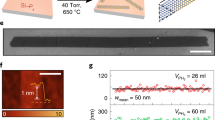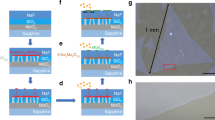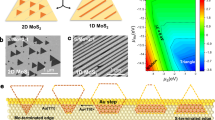Abstract
Chemical vapour deposition of two-dimensional materials typically involves the conversion of vapour precursors to solid products in a vapour–solid–solid mode. Here, we report the vapour–liquid–solid growth of monolayer MoS2, yielding highly crystalline ribbons with a width of few tens to thousands of nanometres. This vapour–liquid–solid growth is triggered by the reaction between MoO3 and NaCl, which results in the formation of molten Na–Mo–O droplets. These droplets mediate the growth of MoS2 ribbons in the ‘crawling mode’ when saturated with sulfur. The locally well-defined orientations of the ribbons reveal the regular horizontal motion of the droplets during growth. Using atomic-resolution scanning transmission electron microscopy and second harmonic generation microscopy, we show that the ribbons are grown homoepitaxially on monolayer MoS2 with predominantly 2H- or 3R-type stacking. Our findings highlight the prospects for the controlled growth of atomically thin nanostructure arrays for nanoelectronic devices and the development of unique mixed-dimensional structures.
This is a preview of subscription content, access via your institution
Access options
Access Nature and 54 other Nature Portfolio journals
Get Nature+, our best-value online-access subscription
$29.99 / 30 days
cancel any time
Subscribe to this journal
Receive 12 print issues and online access
$259.00 per year
only $21.58 per issue
Buy this article
- Purchase on Springer Link
- Instant access to full article PDF
Prices may be subject to local taxes which are calculated during checkout






Similar content being viewed by others

References
Shi, Y., Li, H. & Li, L.-J. Recent advances in controlled synthesis of two-dimensional transition metal dichalcogenides via vapour deposition techniques. Chem. Soc. Rev. 44, 2744–2756 (2015).
Kang, K. et al. High-mobility three-atom-thick semiconducting films with wafer-scale homogeneity. Nature 520, 656–660 (2015).
Chen, Y.-J., Cain, J. D., Stanev, T. K., Dravid, V. P. & Stern, N. P. Valley-polarized exciton-polaritons in a monolayer semiconductor. Nat. Photon. 11, 431–435 (2017).
Wachter, S., Polyushkin, D. K., Bethge, O. & Mueller, T. A microprocessor based on a two-dimensional semiconductor. Nat. Commun. 8, 14948 (2017).
Nie, Y. et al. First principles kinetic Monte Carlo study on the growth patterns of WSe2 monolayer. 2D Mater. 3, 025029 (2016).
Van Der Zande, A. M. et al. Grains and grain boundaries in highly crystalline monolayer molybdenum disulphide. Nat. Mater. 12, 554–561 (2013).
Najmaei, S. et al. Vapour phase growth and grain boundary structure of molybdenum disulphide atomic layers. Nat. Mater. 12, 754–759 (2013).
Wu, S. et al. Vapor-solid growth of high optical quality MoS2 monolayers with near-unity valley polarization. ACS Nano 7, 2768–2772 (2013).
Li, S. et al. Halide-assisted atmospheric pressure growth of large WSe2 and WS2 monolayer crystals. Appl. Mater. Today 1, 60–66 (2015).
Li, X. et al. Two-dimensional GaSe/MoSe2 misfit bilayer heterojunctions by van der Waals epitaxy. Sci. Adv. 2, e1501882 (2016).
Li, X. et al. Large-area synthesis of high-quality and uniform graphene films on copper foils. Science 324, 1312–1314 (2009).
Kim, K. S. et al. Large-scale pattern growth of graphene films for stretchable transparent electrodes. Nature 457, 706–710 (2009).
Zhang, Y., Zhang, L. & Zhou, C. Review of chemical vapor deposition of graphene and related applications. Acc. Chem. Res. 46, 2329–2339 (2013).
Wang, S. et al. Shape evolution of monolayer MoS2 crystals grown by chemical vapor deposition. Chem. Mater. 26, 6371–6379 (2014).
Wagner, R. & Ellis, W. Vapor‐liquid‐solid mechanism of single crystal growth. Appl. Phys. Lett. 4, 89–90 (1964).
Morales, A. M. & Lieber, C. M. A laser ablation method for the synthesis of crystalline semiconductor nanowires. Science 279, 208–211 (1998).
Wu, Y. & Yang, P. Direct observation of vapor-liquid-solid nanowire growth. J. Am. Chem. Soc. 123, 3165–3166 (2001).
Arenal, R., Stephan, O., Cochon, J.-L. & Loiseau, A. Root-growth mechanism for single-walled boron nitride nanotubes in laser vaporization technique. J. Am. Chem. Soc. 129, 16183–16189 (2007).
Rosenfeld Hacohen, Y., Popovitz‐Biro, R., Grunbaum, E., Prior, Y. & Tenne, R. Vapor-liquid-solid growth of NiCl2 nanotubes via reactive gas laser ablation. Adv. Mater. 14, 1075–1078 (2002).
Yella, A. et al. Bismuth-catalyzed growth of SnS2 nanotubes and their stability. Angew. Chem. Int. Ed. 48, 6426–6430 (2009).
Peng, H. et al. Aharonov-Bohm interference in topological insulator nanoribbons. Nat. Mater. 9, 225–229 (2010).
Geng, D. et al. Uniform hexagonal graphene flakes and films grown on liquid copper surface. Proc. Natl Acad. Sci. USA 109, 7992–7996 (2012).
Zavabeti, A. et al. A liquid metal reaction environment for the room-temperature synthesis of atomically thin metal oxides. Science 358, 332–335 (2017).
Chen, J. et al. Chemical vapor deposition of large-size monolayer MoSe2 crystals on molten glass. J. Am. Chem. Soc. 139, 1073–1076 (2017).
Suzuki, H. et al. Wafer-scale fabrication and growth dynamics of suspended graphene nanoribbon arrays. Nat. Commun. 7, 11797 (2016).
Ismach, A., Segev, L., Wachtel, E. & Joselevich, E. Atomic‐step-templated ftormation of single wall carbon nanotube patterns. Angew. Chem. Int. Ed. 116, 6266–6269 (2004).
Tsivion, D., Schvartzman, M., Popovitz-Biro, R., von Huth, P. & Joselevich, E. Guided growth of millimeter-long horizontal nanowires with controlled orientations. Science 333, 1003–1007 (2011).
Gong, Y. et al. Tellurium-assisted low-temperature synthesis of MoS2 and WS2 monolayers. ACS Nano 9, 11658–11666 (2015).
Shen, Y. et al. Epitaxy-enabled vapor-liquid-solid growth of tin-doped indium oxide nanowires with controlled orientations. Nano Lett. 14, 4342–4351 (2014).
Mudher, K. S., Keskar, M., Krishnan, K. & Venugopal, V. Thermal and X-ray diffraction studies on Na2MoO4, Na2Mo2O7 and Na2Mo4O13. J. Alloy. Compd 396, 275–279 (2005).
Johnson, D., Levy, J., Taylor, J., Waugh, A. & Brough, J. Purification of molybdenum: volatilisation processes using MoO3. Polyhedron 1, 479–482 (1982).
Xia, Y. et al. One‐dimensional nanostructures: synthesis, characterization, and applications. Adv. Mater. 15, 353–389 (2003).
Gnanasekaran, T., Mahendran, K., Kutty, K. & Mathews, C. Phase diagram studies on the Na-Mo-O system. J. Nucl. Mater. 165, 210–216 (1989).
Radisavljevic, B., Radenovic, A., Brivio, J., Giacometti, V. & Kis, A. Single-layer MoS2 transistors. Nat. Nanotech 6, 147–150 (2011).
Splendiani, A. et al. Emerging photoluminescence in monolayer MoS2. Nano Lett. 10, 1271–1275 (2010).
Mak, K. F., Lee, C., Hone, J., Shan, J. & Heinz, T. F. Atomically thin MoS2: a new direct-gap semiconductor. Phys. Rev. Lett. 105, 136805 (2010).
Lin, J. et al. AC/AB stacking boundaries in bilayer graphene. Nano Lett. 13, 3262–3268 (2013).
Kumar, N. et al. Second harmonic microscopy of monolayer MoS2. Phys. Rev. B 87, 161403 (2013).
Malard, L. M., Alencar, T. V., Barboza, A. P. M., Mak, K. F. & de Paula, A. M. Observation of intense second harmonic generation from MoS2 atomic crystals. Phys. Rev. B 87, 201401 (2013).
Li, Y. et al. Probing symmetry properties of few-layer MoS2 and h-BN by optical second-harmonic generation. Nano Lett. 13, 3329–3333 (2013).
Jiang, T. et al. Valley and band structure engineering of folded MoS2 bilayers. Nat. Nanotech. 9, 825–829 (2014).
Zhao, M. et al. Atomically phase-matched second-harmonic generation in a 2D crystal. Light Sci. Appl. 5, e16131 (2016).
Schwarz, K. W. & Tersoff, J. Multiplicity of steady modes of nanowire growth. Nano Lett. 12, 1329–1332 (2012).
Zi, Y., Jung, K., Zakharov, D. & Yang, C. Understanding self-aligned planar growth of InAs nanowires. Nano Lett. 13, 2786–2791 (2013).
Chaudhury, M. K. & Whitesides, G. M. How to make water run uphill. Science 256, 1539–1541 (1992).
Bruno, M., Aquilano, D., Pastero, L. & Prencipe, M. Structures and surface energies of (100) and octopolar (111) faces of halite (NaCl): an ab initio quantum-mechanical and thermodynamical study. Cryst. Growth Des. 8, 2163–2170 (2008).
Gaur, A. P. et al. Surface energy engineering for tunable wettability through controlled synthesis of MoS2. Nano Lett. 14, 4314–4321 (2014).
Wasan, D. T., Nikolov, A. D. & Brenner, H. Droplets speeding on surfaces. Science 291, 605–606 (2001).
Kresse, G. & Furthmüller, J. Efficiency of ab-initio total energy calculations for metals and semiconductors using a plane-wave basis set. Comput. Mater. Sci. 6, 15–50 (1996).
Perdew, J. P., Burke, K. & Ernzerhof, M. Generalized gradient approximation made simple. Phys. Rev. Lett. 77, 3865 (1996).
Blöchl, P. E. Projector augmented-wave method. Phys. Rev. B 50, 17953 (1994).
Nosé, S. A unified formulation of the constant temperature molecular dynamics methods. J. Chem. Phys. 81, 511–519 (1984).
Acknowledgements
G.E. acknowledges the Singapore National Research Foundation for funding the research under an NRF Research Fellowship (NRF-NRFF2011-02) and medium-sized centre programme. G.E. also acknowledges support from the Ministry of Education (MOE), Singapore, under AcRF Tier 2 (MOE2015-T2-2-123, MOE2017-T2-1-134). Y.-C.L. and K.S. acknowledge support from JSPS KAKENHI (JP16H06333). T.T. acknowledges support from JSPS KAKENHI (JP16H00922). Jing W. acknowledges A*STAR Pharos Funding from the Science and Engineering Research Council (grant no. 1527200015). F.D. acknowledges support from the Institute for Basic Science (IBS-R019-D1). S.L. acknowledges Y. Sun for helpful discussion and thanks all staff members of the Nanofabrication group at NIMS for their support.
Author information
Authors and Affiliations
Contributions
S.L. designed and conducted the VLS growth. Y.-C.L. and K.S. performed and interpreted the STEM data. S.L., Jing W., Y.S., D.-M.T, C.L., Wen Z., F.D. and G.E. interpreted the VLS growth. Z.W., H.Z., Z.S., Q.-H.X. and A.T.S.W. performed and analysed the SHG data. S.L., Junyong W., Weijie Z. and L.C. studied and analysed the Raman, photoluminescence, AFM and electrical properties. S.L. and Q.Z. performed the TGA and XRD experiments. S.L., Z.H., W.C., T.T. and M.O. conducted the growth of MoX2, WX2 (X = S, Se, Te) from sodium molybdate and sodium tungstate and analysed the growth products. Wen Z. and F.D. carried out the DFT-MD simulations. S.L., Y.-C.L., Wen Z., F.D. and G.E. wrote the paper. All the authors discussed and commented on the manuscript.
Corresponding authors
Ethics declarations
Competing interests
The authors declare no competing interests.
Additional information
Publisher’s note: Springer Nature remains neutral with regard to jurisdictional claims in published maps and institutional affiliations.
Supplementary information
Supplementary Information
Supplementary Figures 1–13, Supplementary References
Supplementary Video 1
DFT-MD simulation side-view
Supplementary Video 2
DFT-MD simulation top-view
Rights and permissions
About this article
Cite this article
Li, S., Lin, YC., Zhao, W. et al. Vapour–liquid–solid growth of monolayer MoS2 nanoribbons. Nature Mater 17, 535–542 (2018). https://doi.org/10.1038/s41563-018-0055-z
Received:
Accepted:
Published:
Issue Date:
DOI: https://doi.org/10.1038/s41563-018-0055-z
This article is cited by
-
Salt-assisted vapor–liquid–solid growth of high-quality ultrathin nickel oxide flakes for artificial synapses in image recognition applications
Nano Research (2024)
-
High anisotropy in electrical and thermal conductivity through the design of aerogel-like superlattice (NaOH)0.5NbSe2
Nature Communications (2023)
-
Universal epitaxy of non-centrosymmetric two-dimensional single-crystal metal dichalcogenides
Nature Communications (2023)
-
Composition and phase engineering of metal chalcogenides and phosphorous chalcogenides
Nature Materials (2023)
-
Opposite doping distribution in TMD monolayer regulated by VLS and VSS growth mechanism
Science China Materials (2023)


